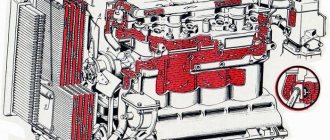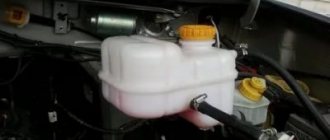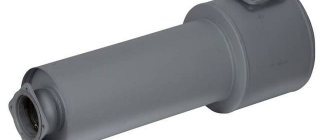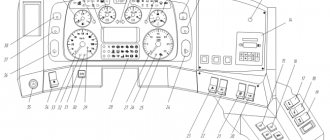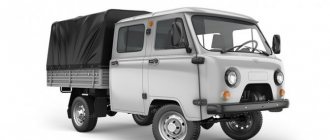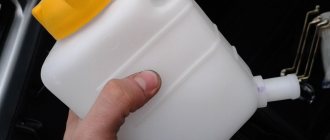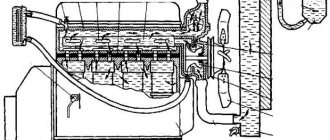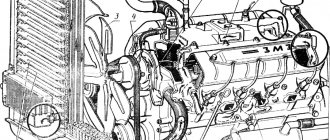Description of the cooling system
The cooling system of the ZIL 130 engine was never modernized during its production history, and therefore the same malfunctions arose. Therefore, car owners continued to struggle with the shortcomings that arose on their own, in some places quite successfully.
To understand how the engine cooling system on the 130 works, it’s worth considering the diagrams.
Rice. 1. Cooling system diagram
1 - radiator; 2 - water pump; 3 - compressor; 4 — bypass hose (bypass); 5 — thermostat; 6 — heater tap; 7 — supply tube; 8 — outlet tube; 3 — heater radiator; 10 — coolant temperature indicator sensor; 11 — dosing insert; 12 - drain valve; 13 — drain valve handle; 14 - drain valve of the radiator pipe
Rice. 2. Water pump
1 - bearing housing; 2 - plug; 3 — oiler; 4 - gasket; 5 - pump housing; S—pump impeller; 7 — oil seal; 8 - sealing washer; 9 — reflector; 10, 12 — ball bearings with seal; 11 — spacer sleeve; 13 — water pump shaft; 14 — fan pulley hub; 15 - fan; 16 - pulley; 17 — generator drive belt; 18 — power steering pump drive belt; 19 — compressor drive belt
Rice. 3. Scheme for checking drive belt tension
1 — crankshaft pulley; 2 — generator pulley; 3 — compressor pulley; 4 — water pump pulley; 5 — power steering pump pulley
Rice. 4. Scheme of remote control of drain taps
1 - drain taps; 2 — handle for driving drain valves; 3 — drain valve of the radiator pipe; 4 — handle for driving the drain valve of the radiator pipe
Rice. 5. Thermostat operation diagram
a - thermostat in closed position; b — thermostat in open position; 1 — thermostat bottle; 2-active mass (ceresin); .3 - membrane; 4 — guide sleeve; 5-rod; 6 — return spring; 7 — thermostat damper; 8,13- pipes; 9 — damper rocker arm; 10 — thermostat housing; 11-buffer; 12 — clip; I - to the radiator; II - to the water pump
Operating principle
The liquid in the ZIL-130 cooling system is supplied from the radiator to the pump through the lower pipe, after which it enters both cooling jackets of the cylinder block (BC). The refrigerant is heated by removing part of the heat from the cylinders, then rises up, passes through the channels near the exhaust valves and goes into the cooling circuit of the main coolant. At the next stage, the liquid enters the jacket of the inlet pipeline, heating it to improve the formation of the mixture.
After this, the refrigerant bypasses the thermostatic valve and returns through the outlet hose to the radiator, spreading over the brass tubular elements, giving off its heat to them. The cooling of the filler is accelerated by the counter air flow created by a fan or compressor, which is aggregated with the liquid pump shaft and the crankshaft pulley.
Cooling system composition
As it became clear from the diagram, the main elements of the cooling system are a thermostat, radiator, water pump, various pipes, drain valves, fan, compressor, temperature sensor and heater. All these elements make up the cooling system.
Many car enthusiasts are interested in the question: how many liters of coolant does the system hold? The answer to the question is simple, according to the manufacturer’s recommendation, the coolant volume is 28 liters.
Radiator
The cooling system radiator is a part that provides cooling of the coolant using a counter flow of air. On the ZIL 130, the cooling system was installed of an old model, and therefore the radiators were mounted from copper and had a 3-row system.
Considering the service life of the motor, operation on water and the age of the parts, these elements often fail. This is primarily due to wear and corrosion, since you rarely see ZILs that are operated on antifreeze. Usually, to save money, these vehicles are usually cooled with water, often not even distilled. Replacing a radiator takes quite a long time, since the location of the part is quite inconvenient.
Fan
The fan is installed forced and mounted on a pulley of the water pump, which is driven by a belt from the crankshaft. The main problem that may arise is the breakage of the fan blades or attachments to the pulley.
Thermostat
Thermostat - provides regulation of the flow of coolant from a small circle to a large circle and vice versa. This is done to ensure maximum cooling or heating effect of the power unit. This part is most susceptible to malfunction, since a stuck thermostat often leads to boiling of the motor. This will all lead to negative consequences.
In order to replace the thermostat, it is necessary to drain the coolant level from the system, and then unscrew the upper pipe from the thermostat cover. Then, you need to unscrew the top cover of the thermostat mount and remove the product directly. The next step will be installing a new spare part and filling in antifreeze. As practice shows, about 0.5-1 liter of liquid is lost during the change process, so it is recommended to purchase the required amount.
Water pump
The water pump or water pump circulates coolant throughout the system. It has a centrifugal design. In case of minor damage, this part can be easily repaired using a repair kit.
The pump is located on the front cover of the cylinder block. The part consists of a housing, a shaft with bearings and an impeller. Usually, when carrying out repair operations, it is the repair kit that is used.
If the cover is corroded or the shaft mounting seats are worn out, then it is necessary to replace the part.
temperature sensor
The temperature sensor installed on the ZIL 130 was the most primitive, and apart from demonstrative functions, it did not perform any others. By exponential function we mean that the sensor determined the engine temperature and transmitted the indicator to the dashboard, where the driver himself controlled the process. As practice shows, on the remaining operational ZILs the temperature indicator on the dashboard does not work.
Drain taps
Drain valves required to drain coolant from the system. They are located on the cylinder blocks and radiator. As practice shows, if you do not drain the antifreeze for a long enough time, or if the vehicle is operated on water, these parts stick and are quite difficult to unscrew.
Exhaust system
Exhaust gas pipelines are located on both sides of the internal combustion engine (there are two of them in total), at the rate of 4 cylinders per gas pipeline for exhaust gases. Using flanges, exhaust manifolds are connected to the gas pipelines, which then go to a common acoustic filter, or muffler. The acoustic filter is located under the car frame. During the operation of the car, you need to constantly monitor the reliability of the filter’s fixation to the frame, and also check the tightness of the clamps that connect the exhaust manifolds.
Not available:
| № | Part code | Name | Part Information |
| 130-1301035 | Radiator cooling tube | Quantity 1 Model 130 Group Cooling system Subgroup Radiator Part number 035 | Not available |
| 131-1301007-B2 | Radiator assembly | Quantity 1 Model 131 Group Cooling system Subgroup Radiator Serial part number 007 Additionally Interchangeable with a part previously released under the same number | Not available |
| 131-1301010-B2 | Radiator assembly | Quantity 1 Model 131 Group Cooling system Subgroup Radiator Serial part number 010 Additionally Interchangeable with a part previously released under the same number | Not available |
| 301047-P8 | Bolt | Quantity 3 Coating galvanized | Not available |
| 120-1303017 | Pipe gasket | Quantity 2 Model 120 Group Cooling system Subgroup Pipes and hoses of the cooling system Part number 017 | Not available |
| 120-1304022-B | Radiator cap gasket | Quantity 1 Model 120 Group Cooling system Subgroup Radiator cap Serial part number 022 Additionally Interchangeable with a part previously released under the same number | Not available |
| 121-1801028 | Radiator suspension cushion assembly | Quantity 2 Model 121 Group Transfer case Subgroup Transfer case suspension Part serial number 028 | Not available |
| 121-1801040 | Spacer sleeve | Quantity 1 Model 121 Group Transfer case Subgroup Transfer case suspension Part serial number 040 | Not available |
| 130-1015370-B | Drain valve assembly | Quantity 2 Model 130 Group Engine Subgroup Starting motor heater Serial part number 370 Additionally Interchangeable with a part previously released under the same number | Not available |
| 130-1301007-B | Radiator with plug assembly | Quantity 1 Model 130 Group Cooling system Subgroup Radiator Serial part number 007 Additionally Interchangeable with a part previously released under the same number | Not available |
| 130-1301010-B | Radiator assembly | Quantity 1 Model 130 Group Cooling system Subgroup Radiator Serial part number 010 Additionally Interchangeable with a part previously released under the same number | Not available |
| 130-1302010-A2 | Radiator suspension frame with amplifier and mounting bolt assembly | Quantity 1 Model 130 Group Cooling system Subgroup Radiator suspension Serial part number 010 Additionally Interchangeable with a part previously released under the same number | Not available |
| 130-1302029 | Radiator suspension frame cross member | Quantity 1 Model 130 Group Cooling system Subgroup Radiator suspension Part serial number 029 | Not available |
| 130-1303010-B2 | Radiator drain hose for vehicles with bypass | Quantity 1 Model 130 Group Cooling system Subgroup Pipelines and hoses of the cooling system Part serial number 010 Additionally Interchangeable with a part previously released under the same number | Not available |
| 130-1303014-B2 | Upper water jacket outlet pipe | Quantity 2 Model 130 Group Cooling system Subgroup Pipelines and hoses of the cooling system Part serial number 014 Additionally Interchangeable with a part previously released under the same number | Not available |
| 508-1303013 | Exhaust pipe with thermostat | Quantity 1 Model 508 Group Cooling system Subgroup Pipes and hoses of the cooling system Part number 013 | Not available |
| 130-1303025-B2 | Radiator supply hose for vehicles with bypass | Quantity 1 Model 130 Group Cooling system Subgroup Pipelines and hoses of the cooling system Part serial number 025 Additionally Interchangeable with a part previously released under the same number | Not available |
| 130-1303026 | Hose from radiator to underwater pipe manifold | Quantity 1 Model 130 Group Cooling system Subgroup Pipes and hoses of the cooling system Part number 026 | Not available |
| 130-1303028-B | Radiator outlet elbow | Quantity 1 Model 130 Group Cooling system Subgroup Pipelines and hoses of the cooling system Part serial number 028 Additionally Interchangeable with a part previously released under the same number | Not available |
| 130-1303030 | Bypass connecting hose | Quantity 1 Model 130 Group Cooling system Subgroup Pipes and hoses of the cooling system Part number 030 | Not available |
| 130-1303051 | Bottom water jacket outlet pipe | Quantity 1 Model 130 Group Cooling system Subgroup Pipes and hoses of the cooling system Part number 051 | Not available |
| 130-1303095-B | Discharge hose spacer spring | Quantity 1 Model 130 Group Cooling system Subgroup Pipelines and hoses of the cooling system Part serial number 095 Additionally Interchangeable with a part previously released under the same number | Not available |
| 130-1303117-B | Supply hose spacer spring | Quantity 1 Model 130 Group Cooling system Subgroup Pipelines and hoses of the cooling system Serial number of the part 117 Additionally Interchangeable with the part previously released under the same number | Not available |
| 130-1303143 | Upper pipe gasket | Quantity 1 Model 130 Group Cooling system Subgroup Pipes and hoses of the cooling system Part number 143 | Not available |
| 130-1304010 | Radiator plug assembly | Quantity 1 Model 130 Group Cooling system Subgroup Radiator cap Part serial number 010 | Not available |
| 130-1305010-E | Cooling system drain valve assembly | Quantity 1 Model 130 Group Cooling system Subgroup Drain valve Serial part number 010 Additionally Interchangeable with a part previously released under the same number | Not available |
| 130-1305046-B | Crane control handle | Quantity 2 Model 130 Group Cooling system Subgroup Drain valve Serial part number 046 Additionally Interchangeable with a part previously released under the same number | Not available |
| 130-1305053 | Crane control rod bushing | Quantity 3 Model 130 Group Cooling system Subgroup Drain valve Part number 053 | Not available |
| 130-1305065-B | Drain plug | Quantity 3 Model 130 Group Cooling system Subgroup Drain valve Serial part number 065 Additionally Interchangeable with a part previously released under the same number | Not available |
| 130-1305069-G | Crane control rod | Quantity 1 Model 130 Group Cooling system Subgroup Drain valve Serial part number 069 Additionally Interchangeable with a part previously released under the same number | Not available |
| 130-1307010-B4 | Water pump assembly | Quantity 2 Model 130 Group Cooling system Subgroup Water pump Serial part number 010 Additionally Interchangeable with a part previously released under the same number | Not available |
| 130-1308010-06 | Cooling fan assembly | Quantity 2 Model 130 Group Cooling system Subgroup Fan Part number 010 | Not available |
| 130-1309010 | Fan shroud assembly | Quantity 1 Model 130 Group Cooling system Subgroup Fan casing Part number 010 | Not available |
| 130-1310110 | Radiator shutters assembly | Quantity 1 Model 130 Group Cooling system Subgroup Radiator shutters Part number 110 | Not available |
| 130-1310210 | Blind control rod with bracket assembly | Quantity 1 Model 130 Group Cooling system Subgroup Radiator shutters Part number 210 | Not available |
| 130-1310230-A | Blind drive mounting bracket | Quantity 1 Model 130 Group Cooling system Subgroup Radiator shutters Serial part number 230 Additionally Interchangeable with a part previously released under the same number | Not available |
| 130-1310346 | End traction sheath clamp | Quantity 1 Model 130 Group Cooling system Subgroup Radiator shutters Part number 346 | Not available |
| 130-1310453-B | Rear shell clamp bracket | Quantity 1 Model 130 Group Cooling system Subgroup Radiator shutters Serial part number 453 Additionally Interchangeable with a part previously released under the same number | Not available |
| 130-1310455 | Front shell clamp bracket | Quantity 1 Model 130 Group Cooling system Subgroup Radiator shutters Part number 455 | Not available |
| 130-1310477 | Radiator shutter rod shell bushing | Quantity 1 Model 130 Group Cooling system Subgroup Radiator shutters Part number 477 | Not available |
| 130-8101201 | Connecting tube | Quantity 1 Model 130 Group Cabin heating and ventilation Subgroup Heater (body) Part number 201 | Not available |
| 130-8101390 | Heating system faucet assembly | Quantity 1 Model 130 Group Cabin heating and ventilation Subgroup Heater (body) Part number 390 | Not available |
| 201418-P29 | Bolt | Quantity 8 Coating galvanizing and passivation (zinc with chromating) | Not available |
| 201456-P8 | Bolt | Quantity 9 Coating galvanized | Not available |
| 220084-P8 | Screw | Quantity 3 Coating galvanized | Not available |
| 250510-P8 | screw | Quantity 27 Coating galvanized | Not available |
| 250634-P8 | screw | Quantity 3 Coating galvanized | Not available |
| 250871-P29 | Nut M16X1.5-6N6.016 | Quantity 1 Coating galvanizing and passivation (zinc with chromating) | Not available |
| 252017-P8 | Washer | Quantity 2 Coating galvanized | Not available |
| 252155-P2 | Spring washer | Quantity 21 Coating phosphating and oiling | Not available |
| 252178-P29 | Washer | Quantity 1 Coating galvanizing and passivation (zinc with chromating) | Not available |
| 258053-P29 | Cotter pin | Quantity 3 Coating galvanizing and passivation (zinc with chromating) | Not available |
| 258054-P29 | Cotter pin | Quantity 4 Coating galvanizing and passivation (zinc with chromating) | Not available |
| 288004-P8 | Hose clamp | Quantity 2 Coating galvanized | Not available |
| 300351-P | Square | Quantity 1 Coated uncoated | Not available |
| 301361-P8 | Bolt | Quantity 1 Galvanized coating | Not available |
| 302052-P8 | Screw | Quantity 1 Galvanized coating | Not available |
| 305753-P29 | Washer | Quantity 3 Coating galvanizing and passivation (zinc with chromating) | Not available |
| 306700-P | Clamp assembly | Quantity 1 Coated uncoated | Not available |
| 307156-P8 | Hairpin | Quantity 4 Coating galvanized | Not available |
| 308736-P | Clamp | Quantity 1 Coated uncoated | Not available |
| 308766-P | Worm clamp assembly | Quantity 1 Coated uncoated | Not available |
| TS108-1306100-04 | Thermostat assembly | Quantity 1 Model TC108 Group Cooling system Subgroup Thermostat Serial part number 100 | Not available |
Disassembling the water pump
To repair this unit it is necessary to disassemble it. The operation is carried out sequentially according to the following scheme:
- The device is installed and fixed in a vice.
- The nuts are unscrewed, the gaskets and spring washers (3, 2, 1) are removed, the housing (9) is removed.
- The bolt (6) securing the impeller is unscrewed, after which the latter is dismantled.
- The bushing, bearing retaining ring and key are removed.
- The unit roller is pressed out on the press along with the bearings (5).
- The bearings, diagonal bushing and water release valve (4) are removed.
- The race and seal are removed from the impeller (7).
- All parts are washed.
- Unusable and deformed elements are replaced.
- Assembly is carried out in reverse order.
What to do if the engine is flooded with water
There are several ways that water can get into the engine. The problem occurs on cars of various makes and models. Filling the power unit is a risk on a car with any mileage. It’s enough to have bad luck driving through a puddle, crossing a ford, or visiting a gas station with low-quality fuel.
If water has entered the engine, it is necessary to carry out diagnostics as quickly as possible. It is important not only to determine whether the engine is flooded, but also to find ways for moisture to penetrate. If the source of the problem is not eliminated, the internal combustion engine will suffer serious damage. In unfavorable circumstances, only major repairs will help get rid of the breakdowns that have occurred.
Basic faults
Among the common malfunctions of the ZIL-130 cooling system, several points stand out. Among them is overheating of the power unit, which is caused by several factors:
- lack of refrigerant;
- slipping or deformation of the pump or fan belt;
- failure of the clutch-clutch;
- fan malfunction;
- incorrect functioning (sticking) of the thermostat and radiator shutters;
- excessive deposition of lime and salt deposits.
Overheating negatively affects the volumetric capacity of the cylinders with the fuel-air mixture, which can lead to oil burnout or dilution. For this reason, bearing shells melt and pistons jam.
The next malfunction in the ZIL-130 cooling system (volume 28 liters) is engine overcooling. This problem occurs due to jamming of the thermostat and blinds when open or in the absence of insulation materials in winter. Overcooling of the engine provokes friction losses, a decrease in the power of the power unit, and condensation of gasoline vapors that flow down the mirror surface of the cylinder. This action washes away the lubricant, increases the risk of wear of parts, and requires frequent oil changes.
A lack of refrigerant occurs when the coolant leaks or boils out. The leakage of the composition is observed through broken seals in connecting hoses and shut-off valves. In addition, this happens due to the appearance of cracks and deformations in the radiator, cooling jacket, oil seal or cylinder head gasket.
Lack of tightness in connections is a fairly common problem in the ZIL-130 cooling system. Eliminate loose fit by tightening the clamps. If necessary, place a thin strip of metal under it. If a malfunction is observed in some of the taps, they must be ground in. This process consists of dismantling the locking device, unbending it, applying lapping paste to the work surface and grinding it with the usual movements until a matte cavity appears over the entire treated area. If there are cracks in the radiator, they can be temporarily repaired by soldering (the elements will soon need to be replaced).
The appearance of a leak through the control hole in the pump frame indicates damage to the oil seal of this unit. To fix the problem, you need to follow these steps:
- Drain the refrigerant.
- Loosen the fan belt and clamps.
- Disconnect the rubber connecting hose.
- Carefully remove the liquid pump.
- Unscrew the bolt securing the impeller and remove it.
Most often, a rubber seal or a moving washer fails in the oil seal. Faulty elements are replaced, after which assembly and installation are carried out in the reverse order.
How to determine if there is water in the engine
The penetration of moisture into the power unit does not go unnoticed by the engine. There are a number of signs by which you can find out that the engine of a car has been flooded with water:
- the oil level in the crankcase has increased;
- a smoky exhaust appeared;
- an emulsion was detected on the oil dipstick;
- liquid is present in the air filter housing;
- the grease has acquired a reddish color, indicating metal corrosion;
- the ignition system is faulty;
- There is condensation or light brown emulsion on the oil filler cap.
Condensation and emulsion on the oil filler cap
Flooding the engine leads to a drop in its power. Fuel consumption increases. The engine makes strange sounds. If a lot of fluid gets into the internal combustion engine, starting the engine becomes difficult or impossible.
If the unit is flooded from the outside, an external inspection will help identify this. Interruptions will be observed in the operation of the ignition system. The engine will start to rev and the crankshaft speed will fluctuate. Moisture causes problems with electronics.
If you suspect the presence of water in the engine, you need to contact a car service center. Contacting specialists is the surest way to determine the condition of the power unit. Diagnostics at a service station ensures that the causes of moisture penetration into the engine are found.
Starting after removing moisture
It is recommended to start the engine after visiting a car service center and diagnosing the power plant. This will avoid serious damage. Otherwise, trying to start the car engine will result in bent connecting rods and destroyed pistons. Starting with liquid in the combustion chamber will cause the cylinder block to crack or deform.
Starting the engine is allowed if liquid gets on it from the outside, but does not pass inside. First, use a dry cloth to wipe all accessible wires. Moisture damages fuel injection and ignition systems. After wiping the power plant, it needs to dry for a couple of days.
Before starting the engine after moisture has entered, an oil change is required. The presence of water in a lubricant significantly changes its properties.
An oil film does not form well on friction surfaces. This causes excessive wear of internal combustion engine parts. It is recommended to use flushing oil before the final oil change.
Other possible problems
Slipping of the radiator belt is another malfunction characteristic of the ZIL-130 cooling system. How many liters are poured into the radiator is not particularly important. Most often, the problem occurs due to oiling of the drive unit or pulleys. Low belt tension can also cause a malfunction. To get out of the situation, you should wipe these parts with a clean, dry cloth while simultaneously adjusting the belt tension.
Other problems are listed below:
- The electrofriction clutch does not engage. The malfunction occurs as a result of failure of the electromagnetic winding, thermal relay or contact.
- The thermostat is stuck. In the locked position, this problem prevents the passage of fluid through the radiator elements. In this case, the last part remains cold, and the engine is prone to overheating. To eliminate the malfunction, you should check the thermostat by draining the refrigerant and carefully removing the pipe. The part is lowered into a container with clean water and it is slowly heated. During the process, the valve opening should begin at a temperature of 70 degrees. When inspecting the thermostat, pay attention to the presence of scale and the cleanliness of the passage hole in the valve.
- Blinds jamming. This problem in the cooling system of the ZIL-130 compressor occurs if the unit is untimely or insufficiently lubricated. You should remove the cable with the sheath, wash it thoroughly in kerosene and lubricate it in the required amount. To check the operation of the blinds, you need to move the handle to the extreme front position, and then to the same rear position. First, the grates should open completely, and with the next action they should close. The handle should move without effort and be fixed in any position.
What are the dangers of moisture penetration?
The dangers caused by liquid entering an engine depend on the path through which it enters. Mixing moisture with motor oil turns it into an emulsion. The lubricant loses its original properties. If water gets into the oil, the internal combustion engine suffers damage:
- scoring on the surface of the cylinders;
- destruction of valve stem seals;
- wear of the crankshaft and bearings;
- occurrence of piston rings;
- the appearance of backlashes;
- formation of corrosion spots.
What to do if water gets into the engine
The continued viability of the motor depends on the correct actions after moisture enters the engine. The best option in such a situation is to contact a car service. Diagnostics at the DDCAR service station can confirm or refute suspicions of water penetration into the engine.
Driving under your own power with a flooded engine is prohibited, so it is better to call a tow truck or have the car towed.
To prevent increased damage to the power plant when water enters, it is prohibited:
- find out about the performance of the engine by trying to start it;
- try to rotate the crankshaft;
- tow or push a car with the gear engaged.
When turning a lubricant into an emulsion, it is first necessary to find the cause of moisture ingress. This requires a complete check of the motor and related systems. It is recommended to perform it at a car service center. Diagnostics will show worn parts that are important to replace to preserve the life of the internal combustion engine.
On gasoline engines it is possible to expel water from the engine. To do this, you need to unscrew the spark plugs and rotate the crankshaft.
Removing water from the engine through spark plug holes
It will take several days for the power plant to dry out. It is not advisable to start it before visiting a service station.
